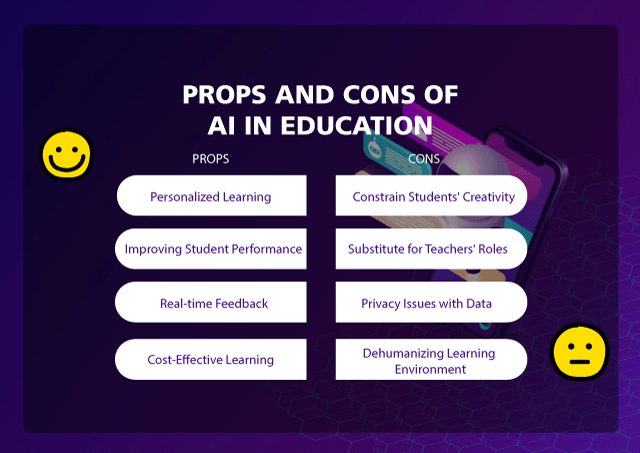Although it’s evident that Artificial Intelligence has increasingly integrated into our lives in 2024, there remain several advantages and disadvantages of AI that warrant further consideration and ongoing debate. In this blog, we’ll explore the various pros and cons of AI in education, as well as the vital role individuals should play in moderating its use. Additionally, we’ll evaluate whether teachers should integrate AI, particularly in the form of EdTech tools, into their teaching strategies.

The Advantages of AI in Education
In today’s modern era, the rapid integration of AI technology into education is evident. AI serves to aid and streamline our daily tasks, making them more manageable. With a simple prompt, tasks that once took considerable time can now be completed in mere seconds. This is just one of the numerous benefits of AI; let’s delve into more!
Personalized Learning
AI has the capacity to generate personalized learning experiences customized to individual student requirements. By analyzing student performance, AI algorithms can adapt learning materials, pacing, and difficulty levels, ensuring personalized educational content for each student.
Improving Student Performance
Another notable advantage of artificial intelligence in education is its ability to boost student performance through enhanced feedback mechanisms. AI-powered systems can assess students’ progress, offer targeted feedback, and pinpoint areas requiring improvement. Furthermore, AI can monitor students’ behavioral patterns, gauge their levels of attention, and identify if they require extra support in particular subjects, specific areas, or certain skills. With instant, AI-driven feedback integrated into enhanced learning experiences, students can expect to elevate their abilities to new levels.
Real-time Feedback
Can artificial intelligence offer students feedback? Absolutely! AI is capable of providing detailed performance feedback to students. This alleviates the burden on teachers by offering simultaneous instruction in a classroom environment. Through this feedback, students can gain valuable insights into their strengths and weaknesses, enabling them to focus on specific areas in upcoming lessons.
Cost-Effective Learning
The Using of AI in education can significantly reduce costs for educational institutions when utilized effectively. AI has the capability to automate numerous tasks across administration, teaching, IT, and more. For instance, AI can handle routine tasks like grading, scheduling, data management, and even tutoring. By incorporating AI into education, institutions can streamline operations and reduce resource requirements, ultimately enhancing cost-effectiveness
Cons and Challenges of AI in Education
While AI offers considerable educational advantages, its development also poses challenges that we may perceive as disadvantages. Let’s explore these together
Constrain Students’ Creativity
In today’s context, many of these challenges can be resolved by students consulting a chatbot such as ChatGPT or Bing AI. While this offers a rapid and convenient means of acquiring knowledge, it can inadvertently constrain students’ critical thinking. Students may become overly reliant on these tools, potentially hindering their ability to think creatively or generate new ideas.
Substitute for Teachers’ Roles
A significant drawback of widespread AI integration in education is the potential threat of replacing the essential role of teachers. If AI can provide instant feedback, access extensive resources, conduct detailed learning outcome assessments, and address all student inquiries, the question arises: What remains the role of teachers?
Privacy Issues with Data
One of the key apprehensions regarding AI usage in education pertains to data privacy. AI systems necessitate extensive data to function optimally, raising the possibility of jeopardizing sensitive student information if it’s mishandled. Stringent regulations are essential to safeguard student data.
Dehumanizing Learning Environment
One of the major drawbacks of AI in education lies in its potential to dehumanize the learning experience. With AI algorithms controlling content generation and lesson pacing, students may miss the personalized guidance offered by human teachers. Additionally, there’s a risk of AI algorithms perpetuating biases, resulting in a curriculum that lacks diversity and inclusivity, consequently failing to address the individual needs of every student.
Examples of Artificial Intelligence in Education
AI can enhance various facets of education. Interested in discovering more? Let’s explore concrete examples of AI applications in educational environments.
Learning Language
Learning a new language has never been easy with Al-powered assistants. Thanks to Al algorithms, lessons are tailored to match individual performance as well as create amazing and unique personalized learning experiences for each student.
Create quiz automatically
Yes, you heard it right! AI can assist teachers in creating online quizzes for online exams or warm-up activities in class. All you need to concentrate on is the question content, as the apps will take care of the layout and color to ensure the quiz slides are appealing and attractive.
Overall School Management
AI is currently being used to manage entire schools, powering student records systems, transportation, IT, maintenance, scheduling, budgeting, etc.
The Future of AI in Education
Though there continues to be widespread debate over the pros and cons of deploying AI technology in the field of education, including the concerns about depersonalization and the ethical considerations cited above, there is an emerging consensus that the extraordinary range of current and future benefits will carry the day.